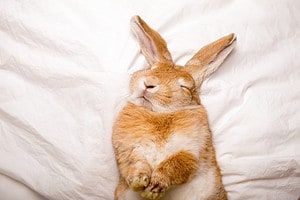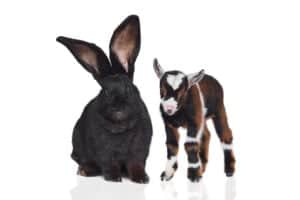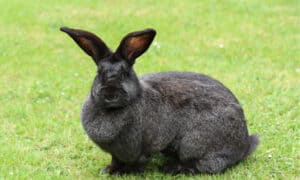In the vast world of adorable creatures inhabiting our planet, few can match the irresistible charm of rabbits. Their twitching noses, elongated ears, velvety fur, and captivating eyes possess an undeniable allure. Hence, it’s no surprise that over 1.5 million American households have embraced rabbits as prized companions.
The American Rabbit Breeders Association (ARBA) acknowledges 50 distinct breeds of rabbits varying in size, color, and other essential features. You can find rabbits as small as the two-pound Holland Lop — the most popular breed worldwide. There are also gigantic rabbits like the 20-pound Flemish Giant. Keep reading to discover more about the different types of rabbits from the cutest to the largest rabbit breeds.
An Introduction to Rabbits
Rabbits are small members of the family Leporidae in the Lagomorpha order of mammals. The European rabbit (Oryctolagus cuniculus) is the only species that humans have domesticated. These captivating creatures have won the affection of humans as pets across Western nations since the 1800s. Yet, their domestication requires an overwhelming amount of care and attention.
Among some popular wild rabbits are cottontail rabbits (in the genus Sylvilagus) and jackrabbits (in the genus Lepus). The male is known as a “buck,” the female a “doe,” while their offspring are known as “kits.” Newborn rabbits enter the world without sight and fur and grow in underground caves in their natural habitat.
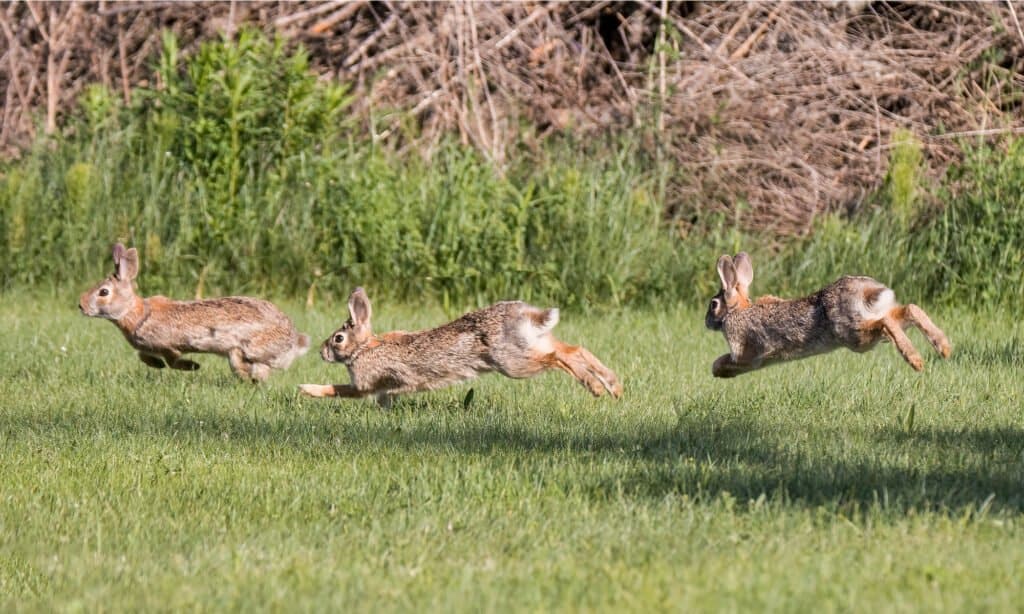
Rabbits come in all shapes and sizes, from the tiny pygmy rabbit, to the large Flemish Giant. No matter which breed you choose, rabbits are always adorable companions.
©Fiona M. Donnelly/Shutterstock.com
Too Cute to Handle: 11 Rabbit Breeds That Will Melt Your Heart
1. English Angora Rabbit
The English Angora rabbit is a marvel of beauty! It holds the position of the smallest among its Angora relatives. With a weight of approximately 5 to 6 pounds, these rabbits have a solid physique with a broad, flat head and compact ears.
The English Angora possesses a thick, woolen, and smooth coat, enveloping their entire body, including their face and feet. The Angora’s fur exhibits diverse colors, determined by the color group to which they belong. The most prevalent color options include white, black, chocolate, chestnut, and blue.
2. American Chinchilla
The Chinchilla emerged in France during the late 1800s. It was bred for its tasty meat and luxurious fur. The American Chinchilla boasts silky, smooth hair, resembling the chinchilla rodent from South America, hence the shared name. At times, people mistake this rabbit for other chinchilla breeds due to their resemblances and the names assigned to those breeds, like:
- The Standard Chinchilla rabbit
- Heavy Weight Chinchilla rabbit
- The Large American Chinchilla rabbit
- Giant Chinchilla rabbit
- Giganta Chinchilla rabbit
The American Livestock Breeds Conservancy classifies the American Chinchilla rabbit as critical on the endangered breeds list. Regardless of the breed, Chinchilla rabbits are gorgeous, and their bunnies are adorable. This widely favored rabbit breed is gentle and suitable for domestication as a pet.
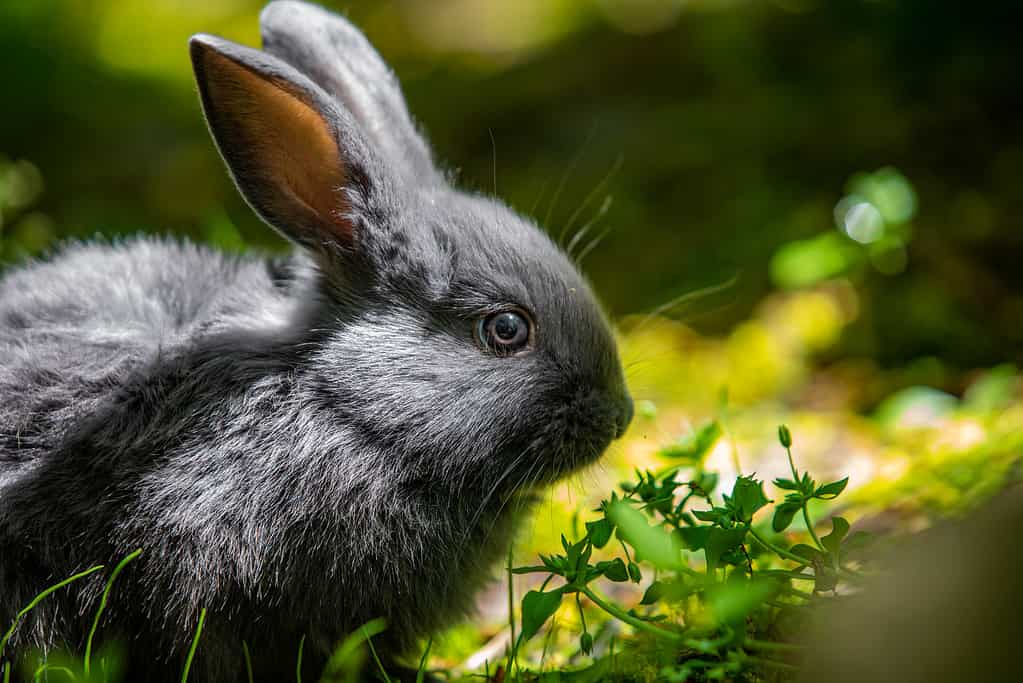
The American Chinchilla rabbit is a breed known for its striking appearance and gentle nature. With its luxurious fur resembling a chinchilla’s, this rabbit captivates hearts with its adorable charm.
©iStock.com/GummyBone
3. Lop-Eared Rabbits
Lop-Eared rabbits, known for their big, floppy ears, are easy to identify. The American Rabbit Breeders Association acknowledges these five varieties:
French Lop
The French Lop, one of the largest breeds of lop-eared rabbits, was developed in France by combining two preexisting lop breeds. This interesting breed of rabbits weighs approximately 10 pounds with ears that hang below their jawline, measuring over a foot in length. While they’re are not the most commonly encountered type of lop-eared rabbit as pets, witnessing their unique ears is quite a sight if you ever have the opportunity to meet one.
Mini Lop
It’s the second smallest lop-eared variety in the United States. It enjoys immense popularity at rabbit shows and can weigh more than 6 pounds, which might surprise many who envision them as smaller. The Mini Lop Rabbit Club of America states that their housing needs are not as demanding as those of larger lop varieties, making them a common choice as house rabbits.
English Lop
They’re among the two original lop-eared rabbit breeds used to develop French Lops. They’re relatively lazy, making them prone to obesity. Given their size, they require a large hutch for accommodation. Their ears are the longest among all rabbit breeds, measuring an average of 20 inches.

English Lop rabbits have the longest ears among all rabbit breeds, measuring an average of 20 inches.
©iStock.com/Naruden
American Fuzzy Lop
The American Fuzzy Lop stands out from the Holland Lop because of its notably short and fluffy wool. When fully grown, this lop-eared rabbit weighs around 4 pounds and has a compact physique resembling the Holland Lop, except for its wool coat, which closely resembles that of an Angora rabbit. These rabbits exhibit a playful nature and vibrant personalities. They enjoy the company of both humans and fellow rabbits. However, managing and keeping their wool clean can pose challenges.
Holland Lop
Unlike the American Fuzzy Lop, these lops belong to the true dwarf variety, having fur rather than wool. Due to their petite stature, these rabbits are immensely popular among children.
4. English Spot Rabbit
The English Spot rabbit, an ancient breed dating back to the mid-19th century, baffles historians with its mysterious origins. Theories abound, suggesting links to the Great Lorrainese (Giant Papillon), the English Butterfly, and the Checkered Giant.
In 1910, this breed found its way to the United States. Twelve years later, the American Rabbit Breeders Association (ARBA) acknowledged the English Spot, followed shortly by the establishment of the American English Spot Rabbit Club.
These bunnies have unique body patterns on their fur, contributing to their immense popularity. Their endearing appearance and great temperament make them highly sought after as house pets. It weighs between 5 and 8 pounds. Their hind legs extend parallel to their body, while their hips are rounded. Atop their heads, they sport erect, elongated ears. The ARBA recognizes several colors for English Spots, including lilac, gray, blue, black, tortoise, gold, and chocolate.
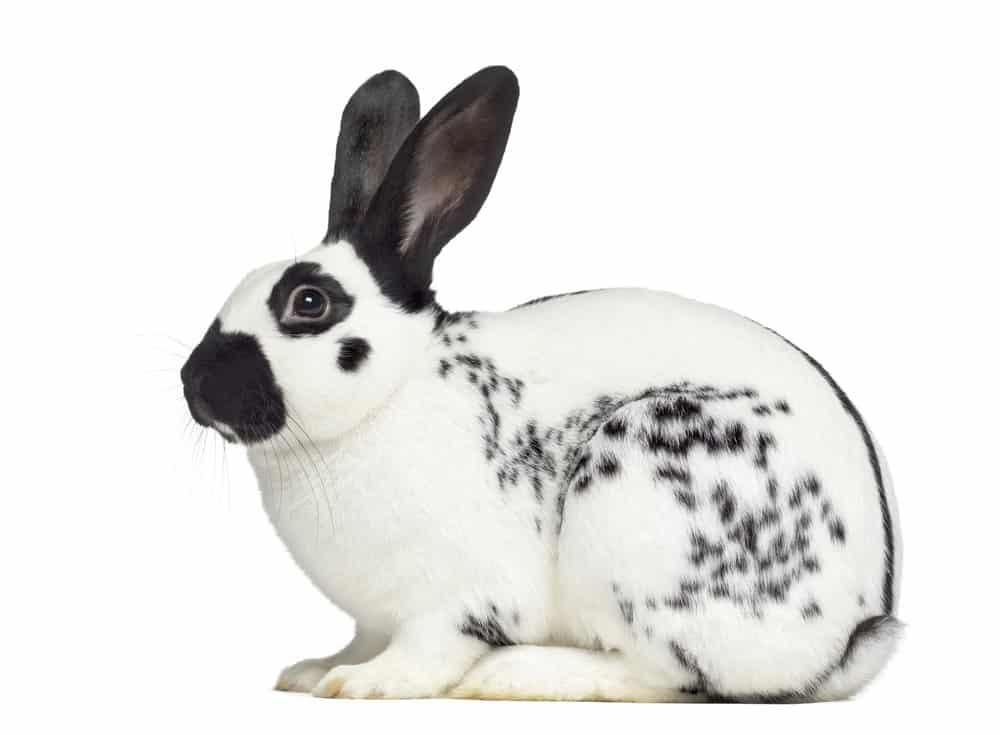
The English Spot rabbit is a breed known for its striking appearance and lively personality. With its beautifully marked coat and vibrant eyes, this rabbit exudes charm.
©Eric Isselee/Shutterstock.com
5. Harlequin Rabbit
The Harlequin rabbit is an exceptional breed renowned for its unique coat colors. It is often called the “clown of rabbits” due to the markings and color separations. Although primarily bred for showcasing their splendid coats, these rabbits are also cherished as companions. They are gentle and friendly, making them ideal playmates for children.
The Harlequin breed emerged in France around 1880 by crossbreeding truly wild rabbits with the semi-wild Tortoiseshell Dutch rabbit. In the 1920s, the Harlequin was first documented in the United States. Notably, the Harlequins were used for meat during World War II. Harlequins are born in litters of around five to six kits. These rabbits fall into the medium to large category, typically weighing between 6.5 and 9.5 pounds. Female Harlequins, known as does, tend to be heavier than their male counterparts.
The distinguishing feature of the Harlequin breed lies in their unique coat colors, which depend on whether they belong to the Japanese or Magpie variety. Japanese Harlequins typically exhibit shades of orange and are accompanied by blue, black, lilac, or chocolate markings. On the other hand, Magpie Harlequins display white fur instead of orange, with similar blue, black, lilac, or chocolate markings.
6. Lionhead Rabbit
The Lionhead rabbit originates in Belgium, where breeders decided to breed a Swiss Fox with a Netherland Dwarf rabbit. This unusual combination led to a genetic anomaly causing wool-like fur to emerge around the rabbit’s head and flanks, eventually dubbed the “mane” gene.
These rabbits’ distinctive appearance shortly captured people’s fascination worldwide and were subsequently imported to the United States in the late 90s. Despite being a miniature breed, Lionheads don’t exceed 3.5 pounds. They possess a compact body structure, and their ears stand upright atop their heads.
The only surefire way to determine whether a bunny has a single or double mane is by examining it shortly after birth. A double-mane Lionhead exhibits a noticeable V shape around its skirt, whereas a single-mane Lionhead appears indistinguishable from any other newborn rabbit. A Lionhead can also inherit no mane genes, leading to what is known as a no-mane Lionhead.
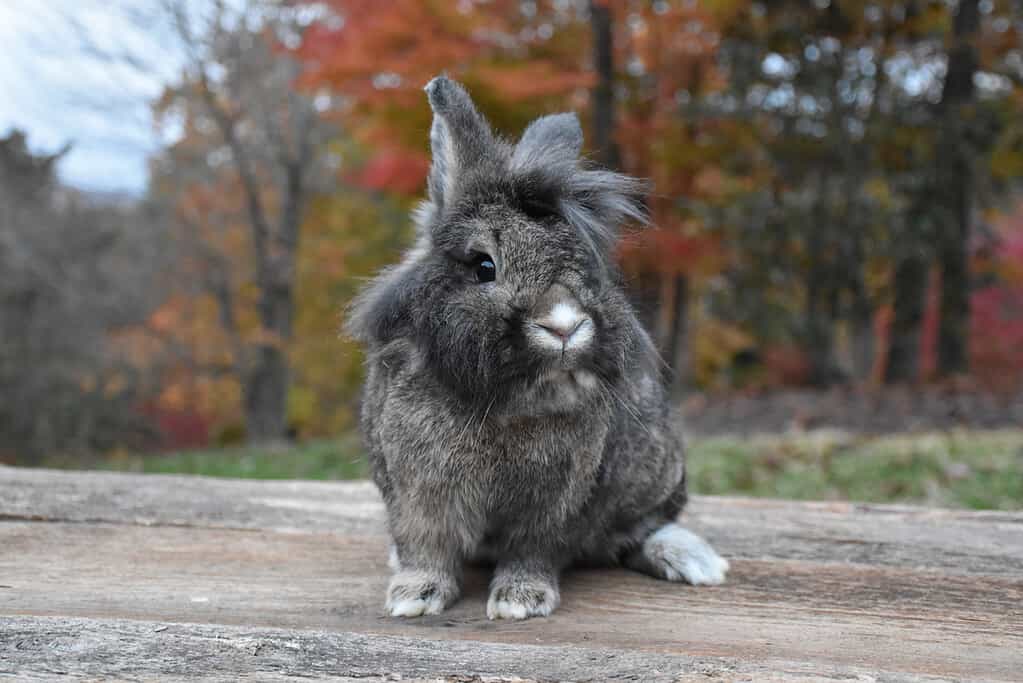
The Lionhead rabbit is a breed known for its distinctive fluffy mane and irresistible charm. With its mane resembling that of a
lion
, this rabbit captures hearts with its unique appearance.
©iStock.com/JudyN
7. Belgian Hare
The Belgian Hare is a domestic rabbit variety bred to resemble a wild hare for meat production. However, they also prove to be delightful companions and exhibition rabbits. Unlike other rabbit breeds that tend to huddle, the Belgian Hare maintains a poised stance, always on the verge of dashing away, with front legs stretched out as if preparing for a race.
The Belgian Hare arrived in the U.S. during the 1880s. Its arrival sparked an extraordinary phenomenon known as the “Belgian Rabbit Boom,” which swept across the country from 1898 to 1901. In this period, many Belgian rabbits were imported to America, with reports stating that one British shipping firm alone sent over 6000 of them to the United States in 1900. In that year, male Belgian rabbits were purportedly fetching exorbitant prices, with one being sold for a staggering $5000.
However, as the market flooded with imported Belgian rabbits, their prices plummeted significantly, reaching less than $25 for top-quality exhibition animals. While they continued to be a common item on menus featuring rabbit cuisine, their popularity waned due to the emergence of commercial breeds that dominated the markets. By the 1940s, the Belgian rabbit breed became increasingly scarce in America and worldwide, and their presence at rabbit shows became extremely limited.
8. Jersey Wooly
In 1984, Bonnie Seeley from High Bridge, New Jersey, introduced the Jersey Wooly rabbit to the American Rabbit Breeders Association (ARBA). This peculiar bunny resulted from breeding the French Angora rabbit with a Netherland Dwarf rabbit. It’s small in size and has a coat resembling wool. It took the ARBA four years to acknowledge this breed as the Jersey Wooly rabbit in 1988.
Recognized for their gentleness, the Jersey Wooly has earned the nickname “No-Kick Bunny” due to their docile and even-tempered nature.
The Jersey Wooly rabbit can be described as compact, weighing between 1-3 pounds, placing it in the dwarf breed category. It boasts little, erect ears measuring approximately 2-3 inches long. With its square and bold head, this breed has endearingly acquired the moniker “Mug Head.”
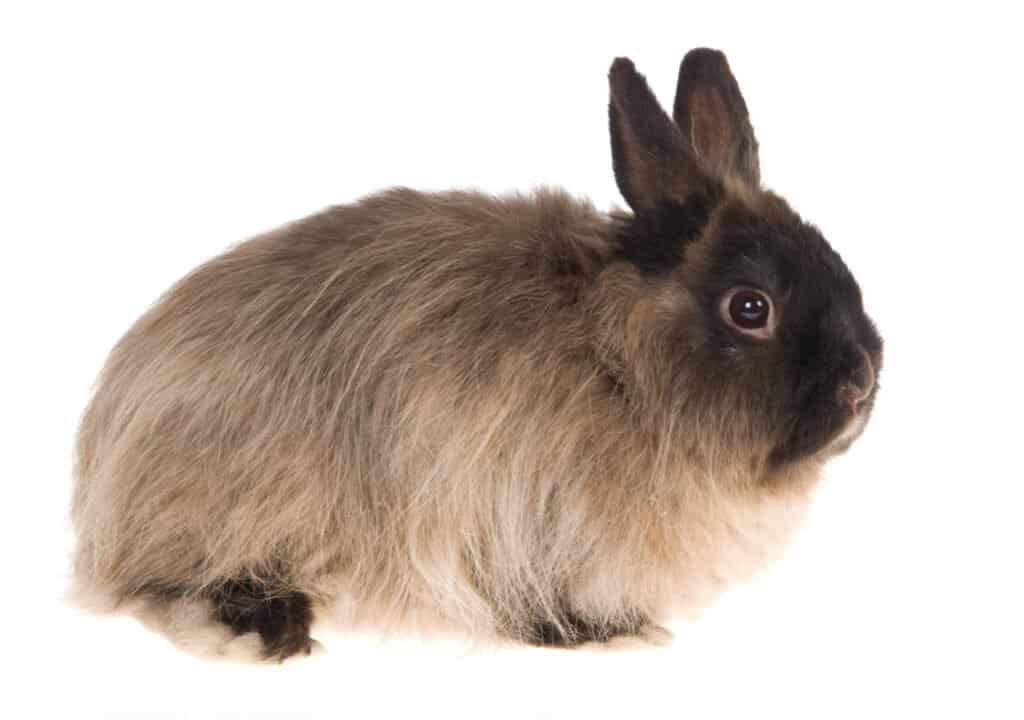
Meet the Jersey Wooly rabbit, a breed known for its luxurious woolly coat and adorable charm. With its fluffy fur and compact size, this rabbit is a bundle of cuteness.
©Linn Currie/Shutterstock.com
9. Himalayan Rabbit
The true origins of the Himalayan breed are shrouded in mystery. These rabbits with white fur and dark markings on their ears, nose, and feet have been observed across various regions worldwide for centuries. They have been given numerous names, such as Black Nose, Egyptian, Russian, and Chinese. This breed is incredibly ancient and widespread.
Scientists have conducted studies revealing that the British Himalayan breed has no genetic connection to a similar breed developed in France during the same period, indicating different origins. The Himalayan breed, as we recognize it today, originated in Britain during the mid-19th century. It is believed that English merchant adventurers brought rabbits back from the Himalayas, contributing to the development of this breed.
The Himalayan breed was selectively bred for its unique coloring and high-quality fur, gaining popularity as a commercial and exhibition breed. The original Himalayans had a black coat, and through crossbreeding, a blue variety was achieved, followed by the introduction of several other colors. In the early 1900s, the Himalayan breed was exported to the United States.
10. Dwarf Hotot
Although some would say that the Dwarf Hotot is a smaller version of the Hotot rabbit, this assumption is simply inaccurate. The formation of this breed involves blending various rabbit types with the standard Hotot. The Hotot lineage can be traced back to the early 1900s in France, with Baroness Bernard playing a pivotal role in its development. It was during the 1970s, through deliberate breeding endeavors in both East and West Germany, that the Dwarf mutation emerged.
Initially, two breeders pursued breeding this same rabbit separately, but eventually, they joined forces and crossbred their stocks. Through their collaboration, the Dwarf Hotot came into existence by combining the White Hotot and the Netherland Dwarf varieties. Elizabeth Forstinger, a resident of California, receives due recognition for introducing seven Dwarf Hotots from West Germany to the United States in 1970, ultimately paving the way for their inclusion in exhibitions under the auspices of the ARBA in 1980.
When these tiny rabbits reach adulthood, they weigh approximately 2.5 to 3.5 pounds. Their heads adopt an exceptional roundness, complemented by a short neck. Their hindquarters exhibit a rounded contour, aligning harmoniously with their broad shoulders, while their ears stand erect. The coat of the Dwarf Hotot rabbit boasts three desirable attributes: short, dense, and lustrous; it requires minimal upkeep.
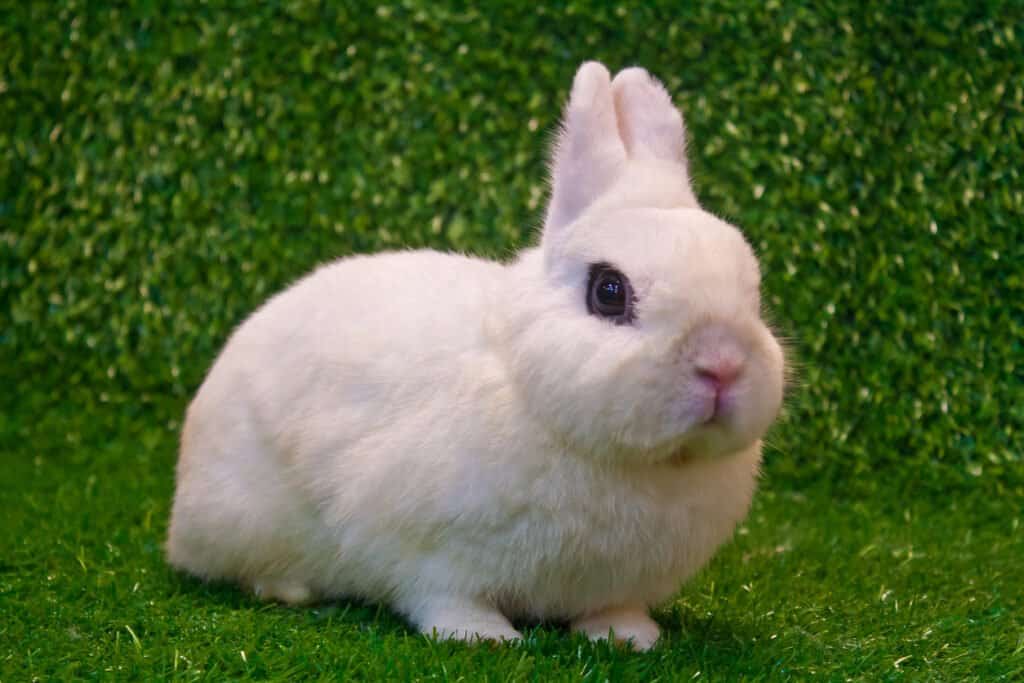
Introducing the Dwarf Hotot rabbit, a breed known for its petite stature and captivating black eye circles.
©iStock.com/Naruden
11. Flemish Giant Rabbit
In the world of domesticated rabbits, one particular species reigns supreme in both size and awe-inspiring presence: the Flemish Giant. Casting your eyes upon this magnificent creature, you might initially mistake it for a canine, so unusual is its stature. These rabbits have an average weight of 15 pounds and a length extending up to 2.5 feet.
The Flemish Giants exhibit broader heads while their female counterparts flaunt a dewlap, an extensive fold of skin beneath the chin that serves as a nurturing incubator for their offspring. As per breed standards, the ideal specimen of a Flemish Giant features a substantial and well-proportioned head, a coat of even hue, a long and robust body, erect ears, and a delightfully rounded posterior.
Cloaked in lustrous and thick fur, Flemish Giants boast a rich array of colors. The National Federation of Flemish Giant Rabbit Breeders in the United States officially recognizes seven distinct shades. These are black, white, blue, gray, steel gray, light gray, fawn, and sandy.
Rabbit Breeds That Guarantee Heart-melting Cuteness
The world of rabbits presents an extensive assortment of breeds, each possessing distinctive traits and appeal. From the endearing English Angora with its woolen coat to the awe-inspiring Flemish Giant boasting remarkable size, rabbit breeds exist to captivate animal enthusiasts across the globe.
It is crucial to acknowledge that while rabbits can make splendid pets, their domestication demands attentive care. Comprehending the specific requirements of each breed, including grooming needs and housing accommodations, is imperative to guarantee their well-being.
The photo featured at the top of this post is © iStock.com/Sonsedska
Thank you for reading! Have some feedback for us? Contact the AZ Animals editorial team.



